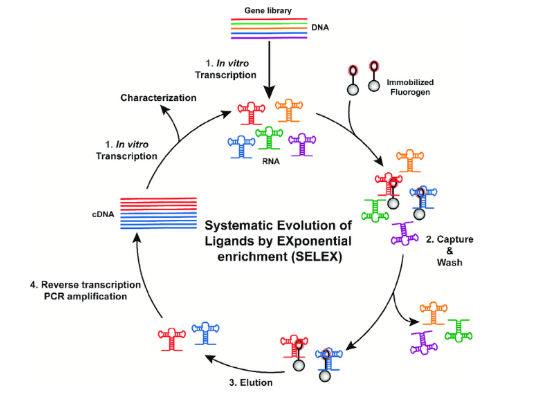2024-05-10 Hits(340)
Selex-Aptamer Screening
Introduction to Aptamer Screening
Aptamers are short 20-80 nt single-stranded DNA or RNA sequences or proteins that are used to bind target molecules because of their high affinity and specificity in three-dimensional structures. Because RNA sequences can be synthesized in the laboratory by transcription in vitro, RNA sequences make up the majority of nucleic acid aptamers. And with 2'-OH, potentially providing a more diverse secondary structure than single-stranded DNA molecules.
Aptamers are single-stranded nucleic acids (DNA or RNA) that bind to predetermined targets with high affinity and specificity. They can be defined as "artificial antibodies" and have been widely used in the fields of basic research in life sciences, clinical diagnosis, and drug development.
SELEX is an in vitro method widely used to select oligonucleotides of single-stranded DNA or RNA (also known as aptamers) that bind specifically to target ligands from random single-stranded nucleic acid sequence libraries.
Principle of Aptamer Screening
SELEX technology is a basic method for screening nucleic acid aptamers in vitro. It is a combinatorial chemistry method that gets rid of the dependence on biological systems. Although the aptamers screened by SELEX technology may act in different ways with target molecules of different sizes, the basic principle of their binding is similar, which is due to the interaction between single-chain oligonucleotide bases, often forming many spatial conformations, such as hairpins, pseudojunctions, G-tetramers, etc. Through spatial conformation matching, base stacking in sequences, electrostatic interaction or hydrogen bonding between charged groups, etc., high affinity and high specificity binding between aptamers and target molecules can be achieved.

Figure 1: Diagram of interaction between aptamer and macromolecular target
The basic process of SELEX technology mainly includes: 1) In vitro chemical synthesis of single strand oligonucleotide library; 2) The randomized library is mixed with the target ligand to allow oligonucleotide-target binding; 3) Wash away nucleic acid molecules that are not bound to the target ligand; 4) elution binding aptamers; 5) The bound aptamer was amplified by PCR to generate a secondary library for the next round of screening; 6) Repeat steps (2)-(5) to obtain an aptamer with high affinity and specificity for the target ligand. In vitro aptamer screening technology provided by Kamed Biological can quickly screen candidate target molecules in the experiment of protein (cell, small molecule polypeptide) aptamer screening.
Using the SELEX process, KMD Bioscience provides in vitro aptamer screening services for customers, such as: For protein aptamer screening (cellular aptamer screening, etc.), the customer only needs to provide the target protein or related sequence or serial number, KMD Bioscience will conduct SDS-PAGE detection on the target protein, then make protein library and screen the target protein, then disassemble the screened aptamer, repeat elutation screening, PCR, NGS sequencing, and finally synthesize the aptamer. KMD Bioscience also provides a one-stop service for customers, from gene analysis and synthesis -- protein expression purification -- aptamer screening in vitro, to provide strong support for customers' experiments.

Figure 2: Typical procedure for SELEX method
3. Application of Aptamers
The aptamer has a short screening cycle, low working concentration, small batch difference, simple amplification process, low cost, stability, and easy preservation, and can be transported at room temperature, which is suitable for toxins and low immunogenic antigens. As a class of recognition molecules, aptamers can identify disease markers and pathological cells in molecular medicine, and the molecular weight is small, can be automated and modular synthesis, has good stability, has low toxicity, and is suitable for clinical application of molecular probes and therapeutic drugs.
Because aptamers have high binding specificity and affinity and have some superior advantages over antibodies, they have become an excellent alternative to antibodies in the diagnosis and treatment of blood diseases. Aptamers provide a new set of tools for diagnosis, drug delivery, and treatment of multiple diseases. At present, the interest in therapeutic aptamers is increasing significantly year by year, and several aptamer drugs are undergoing proof-of-concept studies and clinical trials in various stages, and have already shown great potential in the treatment of hematological diseases. Aptamer and its application in the biomedical field is a new interdisciplinary field that has just started. We should seize the opportunity to break through key technologies, systematically carry out research on the use of aptamers for disease diagnosis and treatment, develop new methods, technologies, and new drugs with original innovation and clinical application value for disease diagnosis and treatment, and promote the practical application of aptamers.
References
[1] Wei H, Li B, Li J, et al. DNAzyme-based colorimetric sensing of lead (Pb2+) using unmodified gold nanoparticle probes[J]. Nanotechnology, 2008, 19(9): 095501.
[2] Zein M I H L, Hardianto A, Irkham I, et al. Recent development of electrochemical and optical aptasensors for detection of antibiotics in food monitoring applications[J]. Journal of Food Composition and Analysis, 2023, 124: 105644.
[3] Li L, Ma R, Wang W, et al. Group-targeting aptamers and aptasensors for simultaneous identification of multiple targets in foods[J]. TrAC Trends in Analytical Chemistry, 2023, 166: 117169.